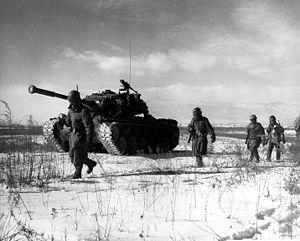Chosin Reservoir Campaign
| Battle of Chosin Reservoir | |||||||
|---|---|---|---|---|---|---|---|
| Part of the Korean War | |||||||
 A column of the U.S. 1st Marine Division move through Chinese lines during their breakout from the Chosin Reservoir |
|||||||
|
|||||||
| Belligerents | |||||||
|
|
|||||||
| Commanders and leaders | |||||||
|
|
|
||||||
| Units involved | |||||||
| see Battle of Chosin Reservoir order of battle | See Battle of Chosin Reservoir order of battle | ||||||
| Strength | |||||||
|
Nominal: 103,520 Committed: ~30,000 |
Nominal: 150,000 Committed: ~120,000 |
||||||
| Casualties and losses | |||||||
|
U.S. sources: 1,029 killed 4,894 missing 4,582 wounded 7,338 non-battle casualties 15 tank losses 17,843 total Chinese estimation: 13,900 |
Chinese sources: 19,202 battle casualties 28,954 non-battle casualties Unofficial estimations: ~60,000 UN estimation: 40,000–80,000 casualties (including non-battle casualties) |
||||||
Coordinates: 40°29′N 127°12′E / 40.483°N 127.200°E
Chinese pyrrhic victory
The Battle of Chosin Reservoir, also known as the Chosin Reservoir Campaign or the Changjin Lake Campaign (Korean: 장진호 전투; hanja: 長津湖戰鬪; rr: Jangjin ho jeontu; Chinese: 长津湖战役; pinyin: Cháng Jīn Hú Zhànyì), was a decisive battle in the Korean War. The name "Chosin" is derived from the Japanese pronunciation "Chōshin", instead of Korean pronunciation "Changjin", of the Chinese word 長津. The UN forces relied on Japanese language maps dating from their occupation of Korea which had ended only five years earlier at the conclusion of World War II. Shortly after the People's Republic of China entered the conflict, the People's Volunteer Army 9th Army infiltrated the northeastern part of North Korea.
...
Wikipedia
